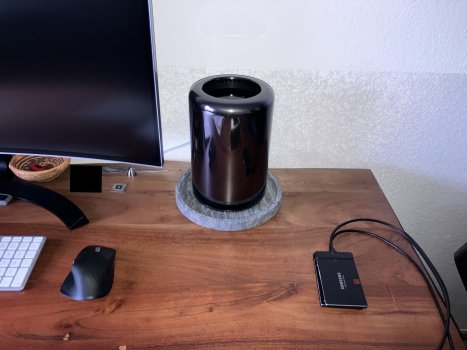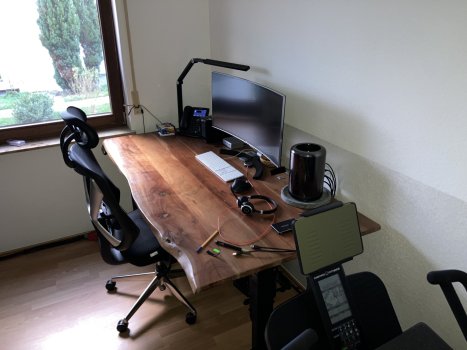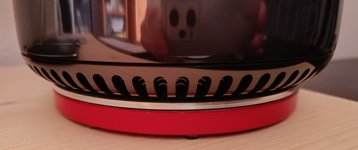There are plenty of threads about adjusting the fan curve with TG Pro, cleaning the inside of the 6.1, giving the PCI bridge a passive heat sink, or simply giving the CPU & GPU this new and high-quality thermal paste.
All of this may have its place. A simple variant that works without internal intervention is passive cooling. No, I'm not talking about the overpriced aluminum turbine from Canada, or even about this crazy notebook stand with a ridiculous LED fan to put underneath. I'm talking about granite or marble slabs that are always cool even in summer. In winter it works even better.
I successfully cooled the first MacMinis with it almost 20 years ago. The idea is that the devices, including the MP 6.1, are usually simply placed on a table or something else by the owner. This is usually wood. For decades, Apple has mostly designed its devices so that their (metal) casing functions as a huge air heat exchanger, among other things.
If, for example, the MP 6.1 is simply placed on a wooden table, the casing inevitably heats up the table it is standing on. Since wood is a good heat storer, it passes this back on to the MacPro in the medium term. Over the duration of its service life, this is a vicious circle that is quite unnecessary.
By placing a marble slab in between, for example, the temperature can be proven to be reduced by a few degrees.
The next improvement is if the marble or granite slab has small rubber feet on the bottom so that it does not lie flat on the wooden table.
Another improvement is if this slab is round, like mine, and has a slightly raised edge. If there is a few cm of space between the MP 6.1 air intake and the slightly raised edge of the marble slab, this acts as minimal dust protection.
It also looks good.
These plates can be bought for very little money on every platform economy in all possible shapes, colors, lacquered or matte. They are usually offered as jewelry storage for the bathroom. Or you can ask your local gravestone manufacturer about remaining stock. With marble, you should just make sure that it is really marble and not a cheap imitation so that you can also take advantage of its thematic advantages.
My marble plate has a diameter of 24cm and a height of 2.5cm. The base is 1.5cm thick. The marble is matte and untreated and has 4 anti-slip rubber pads on the bottom. It weighs around 2.2kg. It is ideal for the MP 6.1. Alternatively, there should also be something like this made of granite.
And I would like to give another tip to those who are thinking of replacing the thermal paste on the GPUs or CPU (if you don't already know). Please take a look at the two following links and implement them, it really does make a difference. Because many people apply some kind of thermal paste and do it mechanically incorrectly. I know this for professional reasons, but I still think of new things for some people. I implemented this on the MP 6.1 with 12 cores and dual D700, but I also do it on all infrastructure systems where possible. It really makes a difference.

 www.pugetsystems.com
www.pugetsystems.com
 www.arcticsilver.com
www.arcticsilver.com
All of this may have its place. A simple variant that works without internal intervention is passive cooling. No, I'm not talking about the overpriced aluminum turbine from Canada, or even about this crazy notebook stand with a ridiculous LED fan to put underneath. I'm talking about granite or marble slabs that are always cool even in summer. In winter it works even better.
I successfully cooled the first MacMinis with it almost 20 years ago. The idea is that the devices, including the MP 6.1, are usually simply placed on a table or something else by the owner. This is usually wood. For decades, Apple has mostly designed its devices so that their (metal) casing functions as a huge air heat exchanger, among other things.
If, for example, the MP 6.1 is simply placed on a wooden table, the casing inevitably heats up the table it is standing on. Since wood is a good heat storer, it passes this back on to the MacPro in the medium term. Over the duration of its service life, this is a vicious circle that is quite unnecessary.
By placing a marble slab in between, for example, the temperature can be proven to be reduced by a few degrees.
The next improvement is if the marble or granite slab has small rubber feet on the bottom so that it does not lie flat on the wooden table.
Another improvement is if this slab is round, like mine, and has a slightly raised edge. If there is a few cm of space between the MP 6.1 air intake and the slightly raised edge of the marble slab, this acts as minimal dust protection.
It also looks good.
These plates can be bought for very little money on every platform economy in all possible shapes, colors, lacquered or matte. They are usually offered as jewelry storage for the bathroom. Or you can ask your local gravestone manufacturer about remaining stock. With marble, you should just make sure that it is really marble and not a cheap imitation so that you can also take advantage of its thematic advantages.
My marble plate has a diameter of 24cm and a height of 2.5cm. The base is 1.5cm thick. The marble is matte and untreated and has 4 anti-slip rubber pads on the bottom. It weighs around 2.2kg. It is ideal for the MP 6.1. Alternatively, there should also be something like this made of granite.
And I would like to give another tip to those who are thinking of replacing the thermal paste on the GPUs or CPU (if you don't already know). Please take a look at the two following links and implement them, it really does make a difference. Because many people apply some kind of thermal paste and do it mechanically incorrectly. I know this for professional reasons, but I still think of new things for some people. I implemented this on the MP 6.1 with 12 cores and dual D700, but I also do it on all infrastructure systems where possible. It really makes a difference.

Thermal Paste Application Techniques
The best technique to apply thermal paste is something that is often debated, and as a whole the internet has not decided on a standard technique. There are many varying techniques that are recommended, so in this article we will best test a variety of techniques to see which performs the best.
Arctic Silver, Inc. - Intel® Application Methods
Attachments
Last edited:




